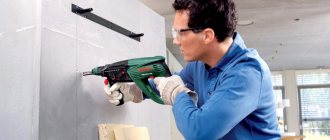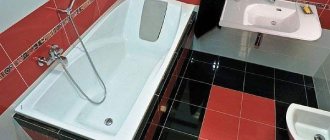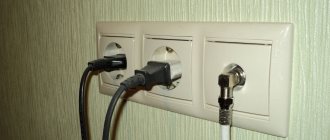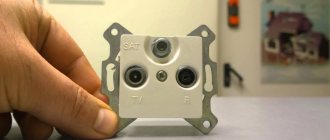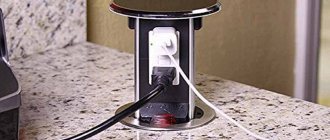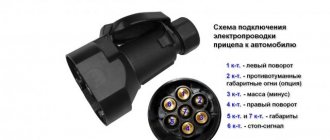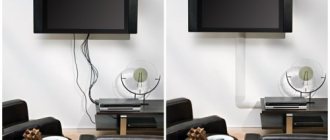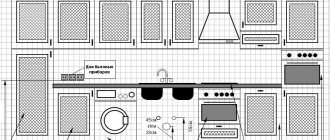Rules for selecting power supply devices
First of all, you need to figure out what and where the furniture will be located, as well as electrical household appliances in the room; for clarity, it is optimal to draw a plan diagram in the correct proportions, on which to indicate all the pieces of furniture and electrical equipment that need to be connected to the electrical network.
Then indicate all the sockets (electrical, television, telephone and computer), it is advisable to make a small reserve. It is preferable to install sockets for devices that do not change their location (TV, system unit, etc.) so that they have constant access, but at the same time, it is better if they are hidden behind this equipment.
Sockets for non-permanent use, installed in open areas of wall structures, should be optimally placed at the same height - thirty centimeters from the floor surface; their number must be selected taking into account that a household vacuum cleaner can reach any room.
Sockets located above a computer desk, chest of drawers, bedside table, etc. are optimally installed at a height of 10-18 cm from the furniture surface. In order to correctly select the installation height of the switch, you first need to determine in which direction the door leaf will open in this room and install the switch on the edge of the door frame where the handle is located. At a height from the floor of approximately 75-95 cm, depending on your height, that is, this distance is determined in practice.
The position of the switches is strongly tied to the type of room, for example, in a narrow corridor or on a flight of stairs, they are usually installed at the start and finish, in the bedroom or living room; it is optimal to install switches near the entrance to the room, as well as at the bedroom places to control lighting while lying down.
Select the height of the switches according to the same rules, taking into account from what position they will be used more often, in other words, if it is at the exit from the room, then we take a height of 75-95 cm, taking into account your height, and if near the bed, then a switch is needed Place it at such a height that it can be easily reached with an outstretched arm.
In those areas where you do not yet know how furniture or electrical devices will be arranged, we recommend installing sockets at a height of thirty centimeters, and switches ninety centimeters from the floor surface; most often this is the most optimal height for switches and sockets.
By putting into practice these simple recommendations, common sense and not forgetting about basic safety, you can find the best location and height of sockets and switches in your apartment. Don’t forget a simple rule: it’s better to calculate and determine everything well in advance than to redo everything all over again later.
How to hide TV wires on the wall: ways to decorate wiring
The simplest and most original solution to the question of how to beautifully hide wires on the wall are various options for external cable camouflage. It can be hidden behind a closet, curtains, or living plants. If there is a cabinet under the TV, the hanging wires should be placed in a vertical box from which small shelves will extend. In this way, an aesthetic and functional design can be achieved.
Decorative panels made of plastic, wood, leather or metal give a good effect. They can differ in different shapes and sizes, covering the wall completely or partially, hiding only the cable products. The decorative finish of the wall lined with natural stone or artificial brick in the area where the TV is located has an original appearance. Different design options are shown in a selection of photos that clearly illustrate how to disguise TV wires on the wall.
Cables don't have to be invisible. With the help of design tricks, they can be turned into decorative elements. For this purpose, special boxes, silicone linings of various configurations, different materials of manufacture and color design, as well as shaped elements are used.
External cable masking is the simplest solution to the problem
For a loft-style room, you can use channels that imitate brickwork. Decor made from small metal structures will look organic. A composition of television branches, made in the form of pipes, will fit well into the high-tech style. In this case, the wiring is fixed to the wall using nails or screws.
In a classic room, you can hang the TV on the wall using wood elements. This design is also suitable for rural country and Provence styles. The composition can be supplemented with butterflies, birds, flowers. A small fence with growing bushes will look interesting.
How to decorate TV wires on the wall: stylish design solutions
Using wires, you can lay out an original composition on a certain theme on the wall. However, for the design to look complete, the cable products must be of sufficient length. The process begins with drawing a sketch of the image on the wall using a simple pencil. When deciding how to hide wires in the kitchen, you should use curly twisting technology, which gives a good visual effect. To do this, using wires, you can lay out a geometric figure on the wall.
When decorating wires, you need to pay attention to the fixing elements; they should not violate the integrity of the cable
If the cable is short or the complex ornament does not fit into the existing interior, you can create an original edging using wires. Branches of green plants decorated with voluminous paper flowers look impressive. Using a television or computer wire, you can create an imitation of a tree branch and decorate it with leaves. If the cable is of considerable length, you can lay out the outline of an entire tree on the wall.
A complex pattern on the wall created from cable products will add brightness and originality to the interior.
Here it is important to think about the color of the wire finish so that it harmonizes with the design of the walls. The drawing can be decorated using various decorative elements. These can be themed stickers, ikebana, handmade items, decorative threads and garlands
The photo shows various interesting ways to hide wires from the Internet and other equipment in an apartment.
These can be themed stickers, ikebana, handmade items, decorative threads and garlands. The photo shows various interesting ways to hide wires from the Internet and other equipment in an apartment.
Implementing an extraordinary option will help solve the problem of how to hide wires in the corridor. It consists of creating a fence from wooden blanks, rising above the baseboard, behind which the cable is hidden. All elements are fixed to the wall using double-sided tape. For originality, you can make a multi-colored fence.
You can hide the wires in special decorative boxes that match the color of the floor or furniture
Fans of unusual design will love the imitation of a power plant created on the wall, to which wires are attached. This option will not only allow you to creatively disguise the wires, but also create a basis for teaching children.
How to properly design sockets for a TV on the wall
Modern TV is a real multimedia station. Game consoles, audio equipment, Internet cables and many other peripherals are connected to the TV. When hanging a TV on the wall, it is very important to correctly design the supply of electrical power and low-current networks: communications must be hidden and at the same time meet safety standards. General rules for the location of TV outlets, as well as specific recommendations for each room in the apartment, are given in the article below.
Height of sockets in the kitchen
This room contains up to half, and sometimes more, of the total amount of home appliances. At the same time, some of the equipment is built-in or stationary, while some is operated exclusively on the table. Therefore, the issue of the location of sockets in the kitchen - the layout and height of placement - should be considered separately.
The diagram above shows one of the options for the arrangement of electrical supply elements for a linear kitchen. It is worth noting that when placing furniture and equipment in corners, the general principle of placement remains the same.
But for an island-type kitchen, the power supply arrangement is a little more complicated - you will need to make an outlet through the floor, under the floor covering, or run cables from the ceiling to provide electricity to electrical appliances located at a distance from the walls. For permanently installed appliances - stove, dishwasher, hood - sockets are also made stationary, hidden (usually they are hidden in tables and cabinets). For small, periodically connected equipment, it is convenient to make a semi-hidden socket, which in the usual position is located under the tabletop, and, if necessary, unfolds with plug sockets up and forward.
Naturally, such devices need high-quality protection from getting wet. You can do this yourself by installing a sealing gasket around the perimeter of the panel being lifted. But it is better to purchase a ready-made factory-made device with a lifting mechanism and a protective panel.
An option with a lifting block of sockets, usually hidden under the countertop, is also convenient, and it is suitable for both an island kitchen and a regular wall-mounted one.
In this case, of course, the lower socket is located at a distance from the tabletop that is not very convenient for connection, but this is compensated by the fact that there are no additional electrical “decorations” on the walls.
If you do not use connection points hidden in the countertop, for equipment with a permanent location, you can use sockets in cabinets. This option is most often used for medium-sized equipment - bread makers, multicookers, food processors, coffee machines, and so on.
The device can be connected constantly or only as needed. You can protect equipment from dust, dirt and moisture with lifting, hinged, sliding or lift-and-turn doors, as shown in the photo above.
If the equipment is “hidden” in the lower cabinets, that is, below the level of the countertop, you can organize pull-out shelves with holders for the cable of the electrical appliance, which does not allow the wire to get between the working elements of the furniture and at the same time holds it in the desired position. In this case, the socket is placed on the kitchen wall (or the back wall of the cabinet).
Similarly, you can make pull-out shelves for equipment placed above the countertop level.
If the hidden installation option is not suitable, the height of the sockets in the kitchen above the countertop is selected according to three criteria:
- Ease of use. A very small distance to the countertop makes it difficult to turn on the appliance and interferes with cleaning the surface;
- electrical network security. Sockets placed almost close to the working surface are at risk - splashes, accidental wetness while cleaning the countertop, small debris can greatly complicate the operation of the device and even lead to a short circuit;
- length of the device wire. Most small, relatively stationary equipment have a short cable length, so you should not raise the sockets too high.
The optimal distance is considered to be 15...30 cm from the table level, and for ease of cable routing it is highly recommended to place all points on the same horizontal line.
There can be three such lines: the bottom one for large stationary appliances, the middle one for sockets above the countertop, the top one for connecting the hood and cabinet lighting.
Important: removing the socket (or a group of them) from the sink by at least 50...60 cm will help reduce the risk of short circuit.
The height of the outlet for the hood is selected either above the level of its placement, or below (under the cabinet in which it is built, or under the bottom panel of the hood itself. In this case, the upper location option is more successful - particles of fat and soot that arise from the plastic external elements of the outlet do not accumulate during the cooking process.
The location of the group of electrical appliances on the same level as the roof rails is quite convenient.
In this case, the distance from the tabletop is 35...50 cm.
An interesting point: in order not to tap or drill the wall for each electrical appliance separately, you can use a special mounting strip. Sockets for connecting equipment and switches are mounted on it in the most convenient order, and the wires pass through the channels of the strip.
Formula for calculating the height of sockets
To accurately calculate the height where all devices will be located, there is a special formula. It looks like this:
H (height) of the TV socket = In the middle of the TV from the floor + D (diagonal) / 2 – In the frame of the socket.
If you place an electrical outlet at this height, it will not be visible from any angle. When the size of the TV is not known, it is recommended to do it at a height of at least 120 cm and no more than 140 cm from the floor. This way you can ensure comfortable viewing of programs and convenient switching on and off of all devices.
Connection diagrams for TV sockets
We've sorted out the types of sockets for TV cables, now let's look at the diagrams.
There are 2 main circuits for connecting television cables and sockets - parallel, also known as “star”, and serial, also known as feed-through. Here, in fact, there are no discoveries of America, the same principles as when installing any electrical networks. Television - differs only in lower voltage and refers to a low current.
Connecting sockets for TV according to the “star” scheme
An apartment most often has one television cable input for connecting one TV receiver. But now few people have only one TV, 2-3, or even more. And they all need to be connected to the cable somehow. This can be done through a splitter or splitter.
The device has an input and several outputs. This scheme using a splitter is called “star”.
As you can see from the figure, there is also a signal amplifier in the circuit. Typically, the input TV cable supplies a set power, which is enough for 1-2 receivers. But if there are more TVs, and the neighbors are not far behind, the input value may not be enough. Alternatively, you can ask for additional power from the company that provides you with “television”. They usually have reserves for this. Or be puzzled by installing the amplifier as in the picture.
Single or terminal TV sockets are suitable for star connection. Because each TV will have its own cable going from the splitter.
One tip for choosing a type. If you plan to occupy all the sockets in a star circuit, both terminal and simple ones will do. If some remain unused, take the end ones so that there is no interference on TV screens. The point here is this. The termination socket has a "built-in" characteristic impedance of 75 ohms, like a line. And she doesn’t care if the cable is plugged into the TV. A single socket has not received “its” resistance for balance and borrows it from the TV. And when there is no connected receiver, the imbalance of the socket with the line is reflected on the screens of other TVs in the form of all sorts of image distortions.
Advantages of a “star” connection
- Convenient cable routing with fastening in the junction box. It’s good for installation and for checking, everything is collected at one point.
- A fault on one line does not destroy the entire system, because the lines are independent. If any incident with a cable or socket happens on one branch, the rest will work as if nothing had happened.
- The television signal loses a minimum of power, but with an amplifier it does not lose at all, but is supplemented with additional power.
As for the significant cable consumption with such a scheme, it depends on how the wiring is done. A good craftsman will “spread” the cable optimally and the difference from pulling one thread will be minimal.
Pass-through connection
The initial data is the same, one input and several TV installation points that need to be provided with TV signals. A pass-through serial circuit or “loop” is the laying of one cable with inserts of pass-through sockets. And installation as the last outlet - the terminal one.
Pass-through sockets are made like a tee, they have an input and 2 outputs, that is, the socket receives the signal and divides it into 2 branches. On one you can put the cable from the TV, and on the second the end of the cable to the next pass-through socket. And the cycle repeats. The last in this chain is the terminal TV socket, which closes the circuit. You don’t even have to plug a TV into it, but it should be there.
As already mentioned, it is undesirable to make such a circuit infinite; the signal power drops from point to point. And even with the installation of an amplifier, using the right cable and the right F-connectors, it can turn out that the latest TVs will show very poorly. Despite the built-in automatic signal amplification and adjustment system in the receivers.
We've at least decided on the schemes, now let's talk about installation.
Which sockets to choose for your TV
TV sockets are divided by purpose: power, Internet, multimedia, etc.
In addition, they differ in design:
- pass-through - with 1 input and 2 outputs (for connecting the next device);
- terminal;
- single (simple).
Sockets are also selected according to the installation method - for hidden installation or external. In the latter option, the wires are usually laid in cable ducts.
Combination type sockets are available for sale:
- tv-rj45 - television and Internet;
- TV-RD - TV and radio;
- tv-sat - terrestrial and satellite television;
- tv-rd-sat - TV, radio and satellite.
A mixer block is often installed with such outlet units. It combines signals from different cables.
Advice! For a more compact placement, you can install sockets with 3 outputs and 2 inputs.
Terrestrial and satellite TV are connected via separate cables. You can connect the sockets to each other using a cable - in a pass-through circuit, in a star circuit, or use single nodes. Sockets can be selected according to color, material and design along with power connectors.
Location options in living rooms
If electrical points can be placed arbitrarily in the hallway, living room and bedroom, then in the kitchen and bathroom it is necessary to take into account safety requirements. Therefore, we will analyze the utility rooms of a private house or apartment separately.
There are no uniform standards that clearly regulate the installation of sockets and switches in living rooms. This gives rise to 3 options for their placement, practiced by craftsmen when installing electrical wiring:
- The so-called Soviet method, used in apartment buildings of the USSR era. Switches are placed approximately at arm's length - 160-170 cm from the floor, and sockets - at a height of 1 m.
- According to European standards. Sockets rise 300 mm above the floors, switches - 900 mm, as shown in the photo.
- Arbitrarily, guided by considerations of ease of use and individual requirements for room design.
The Soviet installation option is considered inconvenient and outdated. The switches are too high for children to reach and turn on the lights. The location of the sockets is unaesthetic and impractical - too high for portable household appliances, and too low for a hanging TV.
To get to the Soviet switch, the child needs to climb on a stool
As a rule, when renovating an apartment or building a private cottage, the owners adopt European standards or develop an individual project for the placement of controls. Regarding the arrangement, we will give the following recommendations:
- Make a plan for each room, where you will place stationary furniture and home appliances.
- In the hallway and living room, provide several connection points for household appliances in the right places. The installation height above the floors is no more than 30 cm. It is better to use ready-made blocks of 2-4 nests, so that if necessary you do not have to use tees.
- In the bedroom, place sockets on the wall at the head of the bed at a height of 40-70 cm, depending on the size of the bedside table. If necessary, interlock them with the light switch.
- For stationary floor-standing equipment (for example, a stereo system), install connection points directly on the baseboard. The plug and wire will be hidden behind the body of the device.
- For a wall-mounted TV, place the connector block at a height of 130-150 cm so that it is behind the top of the device, as shown in the photo.
When small children live in the apartment, sockets installed in plain view must be made safe. Buy special products whose openings automatically close when the plug is unplugged.
How to choose the right place
It is better to position electrical sources so as not to interfere with the operation of the TV. You should know how to install them in different rooms.
In the living room
You need to choose a place to install a television outlet depending on the height of the receiver. The formula for calculating distance looks like this:
Connector height = distance from the floor to the TV + equipment height divided by 2. This calculation is suitable for a TV with a regular antenna when there is no satellite. The connectors are located behind the device. For modern models, you need to additionally install a second socket for the set-top box.
It is recommended to equip a multimedia socket with an HDMI interface behind the receiver, the cable from which will lead to the place where the additional equipment is located.
It is required to press the receiver as tightly as possible against the wall. It should look like a painting and fit seamlessly into the design of the room. If the socket is placed incorrectly, it will be difficult to install the bracket.
The normal height for installing sockets in the living room, where they often watch channels while sitting on a sofa or in an armchair, is 130-140 cm.
In the bedroom
To determine the location of the height of TV sockets in the bedroom, you need to lie down on the bed, relax, close your eyes, then open them and look at the intended location for mounting the TV.
The area where the eye first fell will become the center of the monitor where the bracket is installed. Points to pay attention to when placing the panel:
- height of upholstered furniture - bed, sofa;
- the location from which you plan to watch the receiver;
- electrical equipment settings.
It is recommended that during viewing the angle of deviation from the middle of the display should not be more than 30°.
To make watching TV in the bedroom convenient, it is recommended to install an adjustable bracket that allows you to place the TV in a comfortable position.
When placing the receiver in the bedroom, choose a distance of 1.5 meters from the floor, and install a block of sockets at a height of 25 cm from it.
In the kitchen
Housewives like to watch movies and TV shows while in the kitchen. More often when preparing dishes, so the standard placement of equipment according to the principle “middle of the screen - at eye level” is unacceptable here.
If the TV is equipped with an LCD screen, then in the horizontal plane it has a large tilt angle with a small change in contrast. A vertical plane with a slight tilt darkens the monitor.
If the owners will watch TV while standing, then it should be hung at a distance of 1.75 cm from the floor. If sitting on a chair, then lower.
Many kitchens have a small area, so the only place will be to place the receiver on the wall. Then buy a movable bracket to change the angle of inclination.
Where should sockets and switches be safely placed in living rooms: a review of popular places
Inside the dry rooms of the apartment, safety rules also apply, which should be taken into account when repairing, re-installing and operating wiring.
According to building regulations, cable routes cannot be laid closer than 10 cm from door and window openings, and when placing them under the ceiling, they should be 15-20 centimeters down from the top slab.
When carrying out wiring in the corridor, the apartment panel and electric meter are also located here at a convenient height. Usually this distance is 160 cm. The switch near the front door is usually placed at a height of about 90 cm.
If the branch box is located at the bottom, it is raised to a height of about 30 cm.
Corridor sockets and switches are mounted on the wall near the entrance door.
A modem for a computer is often installed in the hallway. Its location depends on:
- places where the fiber optic cable enters the apartment;
- network configurations of outgoing low-current output circuits;
- conditions of safe access.
An option for the bottom location of the fiber optic modem and the socket for its power is shown in the photo below.
In older apartments you can still find ceiling switches controlled by a cord. The only positive aspect of their use is the reduction in the length of the power cable.
The main disadvantage of their use is that the mechanism wears out quickly and requires periodic repairs.
Sockets in the hall for telephone and TV are conveniently located near the floor at a height of about 30 cm, and for video intercom raised by 1.4 meters.
In the bedroom you can install European sockets and switches near the bedside tables.
An alternative modern way to control bedroom light is to use remote smart home system devices, for example, from Sonoff.
Such modules are installed at the entrance to the bedroom, which allows you to turn on the light by touching the sensor device. It is extinguished by sending a signal from a remote control or smartphone via a radio channel.
Inside the furniture, you can install backlight lamps with a switch built directly into the power cord.
In a modern children's room, switches are placed taking into account the growth of the child who has reached the age when he can already be allowed to control the lighting.
At the same time, do not forget about protecting the outlets. They must be covered with special plastic plugs that protect the electrical contact sockets from accidental contact.
An inquisitive child can put any metal object in his hands there (a hairpin, a nail, an awl, a screwdriver).
It is recommended to place a socket block near the desktop surface to connect lamps, laptops, mobile gadgets, and tools.
Local lighting in the living room
Wall sconces, floor lamps and table lamps located near sofas and armchairs create diffused light that is comfortable both for reading and for a friendly conversation.
Location of wall lights
requires special attention.
- You should not place the sconce directly in front of the TV, as unwanted glare may appear on the screen. If you still want to do this, step back 50 cm on each side of the TV screen projection.
- Sconces in the living room are hung at a height of 1.2 to 1.6 m, depending on the proportions of the room, the height of the ceilings and the design of the sconce (the horn looks up or down).
- In a classic interior, the location of wall lamps should be symmetrical relative to some object on the wall, such as a painting or mirror.
- When hanging wall lamps in the interior of both a modern and classic living room, there should be some kind of logic, connection to a specific object, such as a sofa, armchair or fireplace.
Location of sconces in the living room
At what height should TV sockets be placed in different rooms?
If the TV model is not yet known, then the height of the sockets from the floor is assumed to be 140 cm.
The minimum kit usually consists of:
- TV sockets;
- RJ45 for Internet connection;
- two power sockets for 220 V.
The calculation of the location and composition of the outlet assembly may differ for different rooms of the house.
In the bedroom
You can find out where to put the TV in the bedroom experimentally: lie down, close your eyes, open them and look at the chosen place. They try to place the center of the screen where it is most comfortable to look. It usually turns out that viewing programs and operating equipment is more convenient at a height of 1.5-1.6 m.
For subsequent fine-tuning of the TV position, adjustable bracket designs are used.
To ensure that the TV fits well into the interior, different techniques are used:
- embedding TV into furniture;
- additional frames, for example, imitation of a painting;
- finishing the location with stone, contrasting wallpaper, decorative plaster.
Features of installing switches and sockets in the kitchen
When it comes to installing a socket and switch in the kitchen, then in this situation the issue needs to be given special attention. In the kitchen, as a rule, there is a very large number of different household appliances. In addition, it is in this room that there are a huge number of zones that can be dangerous: these are open fires, stoves that heat up, a large amount of water
It is necessary to pay special attention to safety in this situation.
In addition, it is in this room that there are a huge number of zones that can be dangerous: these are open fires, stoves that heat up, and a large amount of water. Particular attention must be paid to safety in this situation.
You should not use extension cords or adapters in the kitchen, unnecessary wires, which very often cause short circuits and very strong fires that are difficult to extinguish.
How to properly place sockets and switches in the kitchen: video designer tips
In the kitchen, the height of sockets and switches should take into account what features the room has, what electrical and other appliances are there, and also depending on many other nuances.
There are several general rules that everyone should be familiar with:
- The surface where you cook, as well as the sink, are the most dangerous areas; you should not install them near them, because this can result in serious problems.
- The installation of an outlet that ensures the normal and full operation of household appliances in the kitchen must be done next to this appliance or above its surface.
- Very often, people can make the same mistake - they place sockets behind appliances, where it is very difficult, and sometimes even impossible, to reach.
- When you choose a place for an outlet, you must take into account the height of the countertop. This is necessary so that you can provide maximum access to the outlet, during which there will be no inconvenience.
Inconvenient location of sockets and switches video
What height is the location of switches and sockets in an apartment? This is a very important issue that needs to be studied in detail. If you violate some rules and standards, this may result not only in discomfort in the future, but also a serious problem. Incorrect placement of the outlet can lead to a short circuit and then a fire. In addition, this can cause a lot of inconvenience, so you need to follow the rules and treat this issue very carefully. If you cannot independently design the location of devices in a particular room, then use the services of specialists who will help solve this rather important and delicate issue.
Socket design
To ensure easy access to sockets, they are installed on open parts of the walls. As a result, sockets are constantly in sight. In order for them to fit organically into the interior, you need to choose sockets that will suit the style of your bedroom. You can now find many types of sockets in stores. They differ in color, shape, and may have a lid or decorative elements.
For ultra-modern interiors, built-in sockets are suitable, which are hidden in the wall and have a very small external cover.
For interiors in the style of classicism, vintage, Provence and country, sockets decorated in an antique style are suitable. Such sockets, complete with toggle switches and open twisted wiring, beautifully complement the interior. In this case, the wiring, in addition to its practical function, also has a decorative function.
In specialized stores you can find shaped covers that can be placed around any standard socket or switch and make them more elegant.
You can also purchase a special cover for the outlet. These covers are made of plastic; they cover the socket, leaving only the holes for the plug visible. The lid can be smooth or decorated.
The color of the outlet should be chosen to match the wallpaper or the color of the furniture. The most versatile are the classic white sockets and the same switches. If you want to completely hide the outlet, you can paint it to match the wallpaper.
Unusually shaped linings will help diversify the appearance of the sockets. Traditionally, they are made square, but in stores you can find rosettes with oval, round and even shaped overlays that repeat the shape of flowers, animals or cars.
In stores you can find special stickers that are attached around or above sockets. If the rosette cannot be hidden, you can always play around with it by fitting it into some kind of design.
The location of sockets and their installation is an important and critical stage of repair. Once you have decided on the number and location of power supplies, entrust the wiring and installation to a professional electrician. This way you will protect your home from short circuits and significantly speed up repairs.
Types of HDMI sockets
When carrying out renovations in an apartment, you should think in advance about the possibility of installing such sockets near the proposed video equipment. Let's consider 2 main types of these devices.
Depending on the installation location and purpose, such sockets can be receiving or transmitting. These are the cheapest devices, the peculiarity of which is the inability to broadcast a high-quality signal over a distance exceeding several meters.
The main difference between these devices and sockets of the previous type is the amplifier, which significantly increases the signal transmission range (up to 45 meters).
In addition, to connect active HDMI outlets, you do not need to use a special cord, since this is done with twisted pair cables. Of course, this connection method cannot be called optimal, but it is often used due to the high cost of the HDMI cable.
Since the cost of the modification with an amplifier is much higher than its passive counterpart, in most cases it is used only for installation at the output of the receiver, and a connector without an amplifier is installed on the panel of the multimedia device.
Moreover, in the case of using active sockets on both sides, the video signal transmission range increases significantly.
Passive and active
Passive sockets can be either receiving or transmitting, or multifunctional with one or two connectors. In addition, in addition to the HDMI interface, it may have others, for example, audio connectors, telephone connectors, and an antenna connector. The disadvantage of these designs is the impossibility of transmitting content over distances beyond 10 meters.
Although this is not relevant in residential premises. The active solution is capable of transmitting a high-definition signal over a distance of up to 45 meters. This is possible due to the fact that a special amplifier is built into such HDMI sockets.
In this case, no special cable is required. Transmission is carried out over two twisted pair cables. Thus, 1080p content can be transmitted using this active device over a distance of up to thirty meters, 1080i content up to 45 meters.
Sequence of DIY work
Let's look at how to install a TV outlet yourself.
When is gating necessary?
Grooves are used on monolithic and brick walls with large surfaces. This is true for external load-bearing coverings and partitions without the presence of power cords in them. The thickness of the drilling is large, such walls cannot be damaged. To groove internal planes, you will need permission from the construction department.
Installation options without grooves
This open installation involves installing sockets on an external wall without drilling channels and holes for socket boxes. The wires will run outside along the plane.
Also, the optimal solution is to install surface-mounted electrical installations. This option is great when the renovation has already been done and you don’t want to spoil the finish. The connector can even be installed on top of tiles.
Selecting wire cross-section
The indicator is measured in square millimeters and shows throughput. To ensure safe operation of the receiver, purchase a cable with a reserve cross-section, then the insulation will not be damaged by the load.
The wire cross-section is not equal to the diameter. The latter is measured with a ruler, put into a formula and the cross-sectional area is calculated.
The wiring cable is always rounded up. For example: when calculating it turned out to be 2.2 square meters. mm. This means that you need to take a 2.5 square cable.
Fastening and fixing
There are 2 options for connecting the connector. The star pattern means that the old wiring is removed and the new wiring is placed through the splitter. It is designed to branch a signal, divide it into packets and amplify it.
Electrical sources are placed at the entrance of the wire into the living space from the entrance. Then the antenna conductors are wired. Used frequently. Advantages:
- the wires are located in a technically safe place, which is important during installation and routine inspection;
- the signal is stable;
- The separated packages continuously supply current to the TV sockets.
The second installation method is daisy chain. The main cable extends to any TV, and then branches into 2 or more parts to other devices directly at the connector. With this connection scheme, there is a saving on cables. The disadvantage is that the quality on the first TV will be higher than on subsequent ones.
How much wire is needed
Now there are different methods of data transmission that require their own connection to the network. Instead of 1 socket, install a block that contains at least 4 connectors.
Installation of a television socket
Since in modern interiors it is not customary to leave wires in sight, the television cable is usually hidden in the wall along the entire route from the entrance to the apartment to the place where the TV will be installed. Its end is crowned with a socket box, into which the TV socket will subsequently be installed. How to install a socket box should be found in the article.
To simplify further installation and connection of the TV socket, leave the free end of the cable about 30 cm long protruding from the socket.
Before you start connecting the TV socket, you need to prepare the antenna cable sticking out of the socket. Using a knife, remove about an inch of outer insulation from it. Slide the copper braid down a little and unscrew the aluminum foil underneath so that it covers part of the copper.
Next, you need to remove the insulation from the central core of the antenna cable. To ensure a reliable connection, the length of the bare end of the wire should be approximately 8 mm. The remainder can simply be cut off.
Further installation will depend on the type of outlet you choose. For a number of manufacturers, the design includes a fixing cover and a terminal hidden under it. Unscrew the fastening screw of the cover, tilt it, insert the central core of the cable into the terminal until it stops and tighten the screw properly, pressing the wire.
Other models of sockets are equipped with a fastening loop for the cable braid and a screw for fastening the central core. Before connecting the bare end of the wire, thread it through the locking loop. Then position the center core near the screw and tighten it. The preliminary installation is complete, all that remains is to install the socket in the socket box.
Be sure to watch the video below for connecting a TV outlet:
Installing a socket in a socket box
Installation of the assembled television socket at the mounting location is carried out using spacer tabs present in its design. The socket itself is additionally fixed in the wall with mounting screws. Before installing them, check the installation geometry by level and, if necessary, adjust the position of the legs.
Tip: the remaining part of the wire should be laid inside the socket box, twisting it into rings. Try to roll the cable carefully, avoiding unnecessary creases and kinks - this may affect the quality of the signal.
How to install a LeGrant TV socket, watch the video below:
How to choose sockets
The initial stage of installing the necessary equipment is determining the type of wiring. Open wiring is now rare; more often it is hidden by the thickness of the wall. To install the sockets, you will have to make a hole with a puncher or drill, as well as a hole for the socket box. This will allow you to hide the TV outlet and give the room a finished look.
If the wiring is open, you will have to buy overhead electrical sockets. For reliability and better fire safety, the cable should be placed in cable channels. Cable channels are sold in many colors, which can be easily matched to the color of the wallpaper. Then you won’t have to trench the wall; the socket will be installed outside. It should be hidden behind furniture if possible.
There are a number of devices without which it is impossible to connect the latest generation TV. You should also take into account the possibility of connecting additional equipment and calculate the required number of sockets individually. The standard set is as follows:
- Electrical socket - 2 pieces.
- Special TV socket - 1 piece.
- Internet socket - 1 piece.
The last type of device is necessary for everyone - now television is digital almost everywhere. Most providers work with special set-top boxes that will be plugged into an electrical outlet. The second will be occupied by the plug of the TV itself. An antenna will be plugged into the TV socket, from which the cables pass to the central (common house) antenna. In the event of a breakdown or shutdown of digital TV, the standard set of programs will be present. The cable TV wire will also be connected there.
Some TV models allow you to directly connect to the Internet through an Internet outlet. So you can watch movies on the big screen via online channels. A special router cable must be connected to the device. For this purpose, the wires must be laid in the wall or along the baseboard of the cable channel.
Hall sockets
If the TV is installed in the kitchen or bedroom, the set of sockets described above will be sufficient. But to create a “home cinema” in the living room, many additionally install multimedia sockets. This scheme (5 devices) will allow you to create a real cinema at home, including game consoles, computers, DVDs, and other equipment.
All of these devices should be installed close to the TV or behind the furniture on which it stands. If the TV itself can be hung on the wall, then other equipment will have to be placed in designated places, so hiding the sockets can be quite successful. Multimedia devices require the use of HDMI cables. Through such cables, any digital equipment of the latest generations is connected. But if the equipment does not have an HDMI connector, then such sockets will remain unclaimed.
In order to save time and money, many install all devices in one socket box in a single line. The cables need to be stretched generously and plugs must be put on the ends to connect to the TV. This will avoid unnecessary connections and unnecessary wires.
